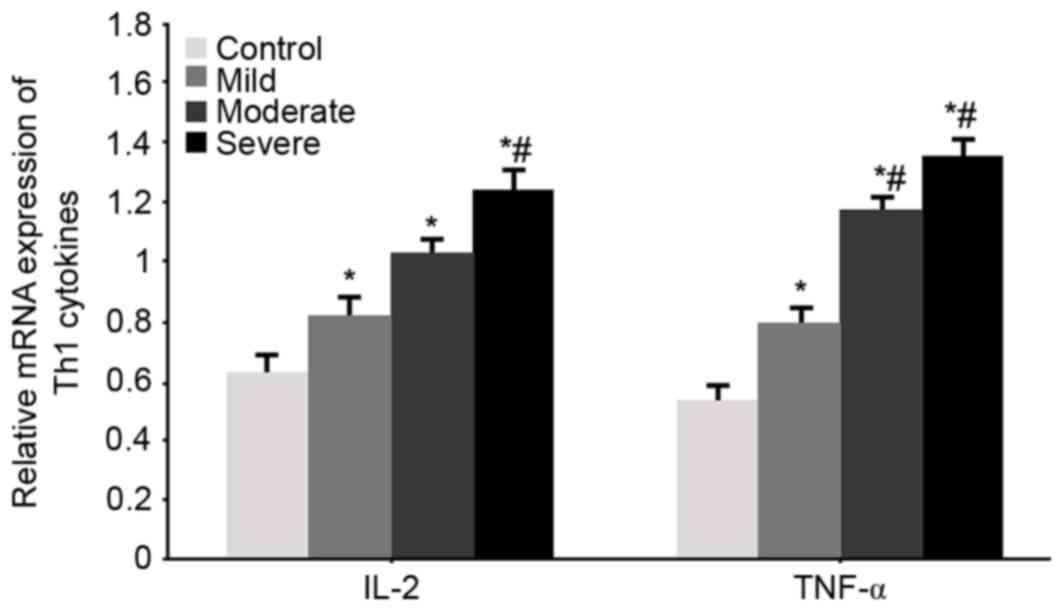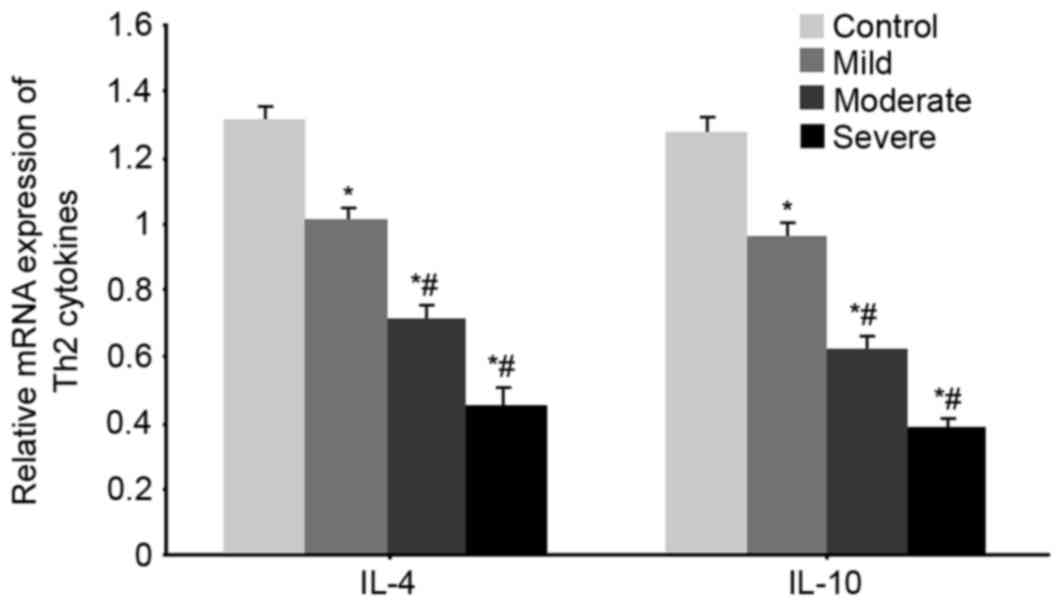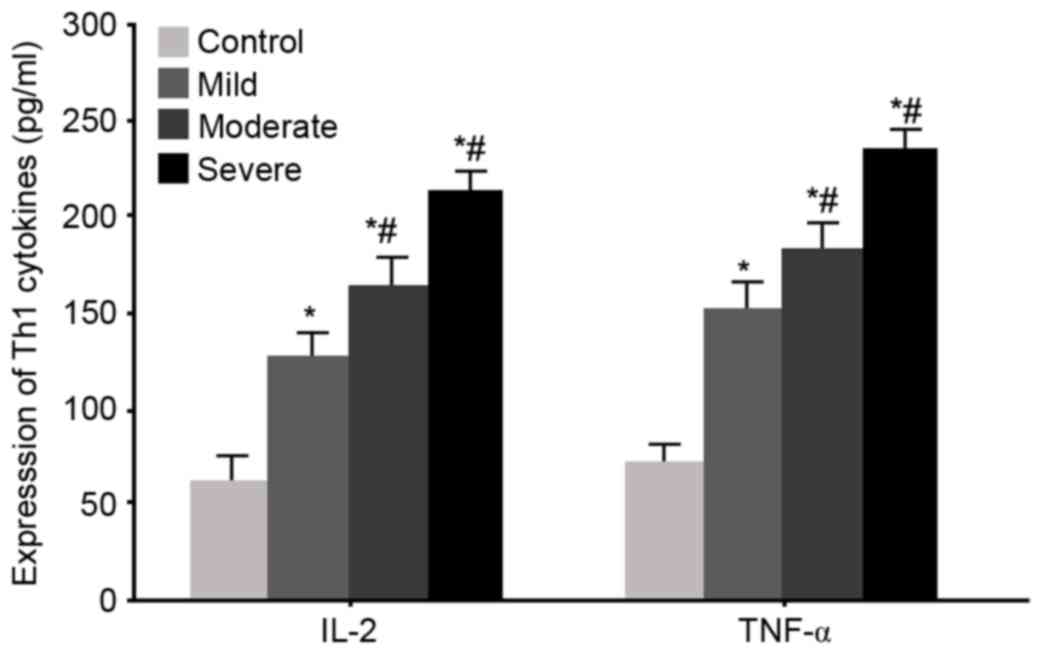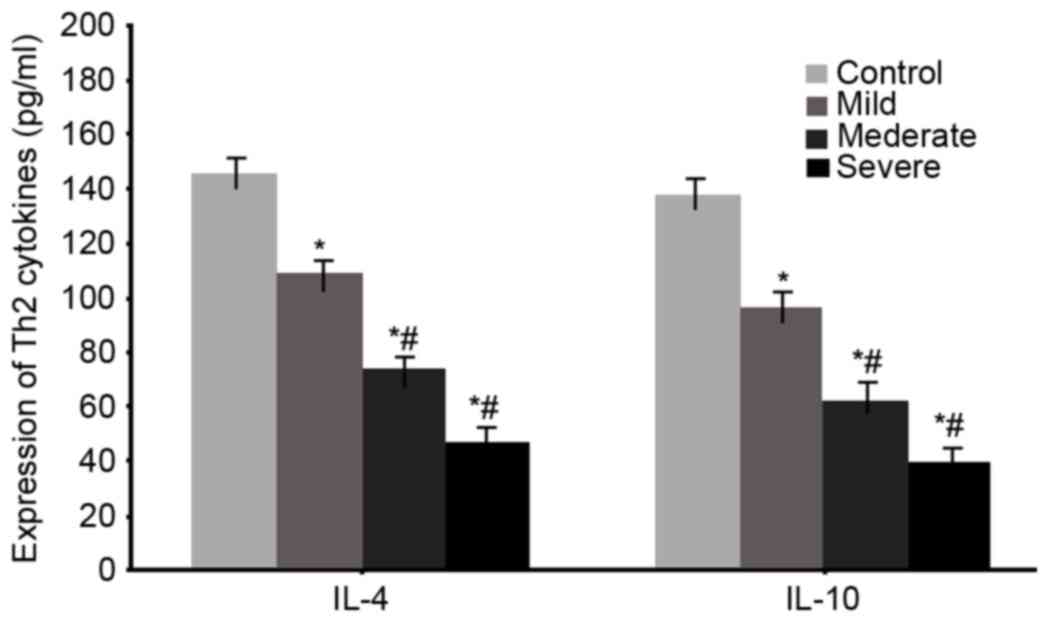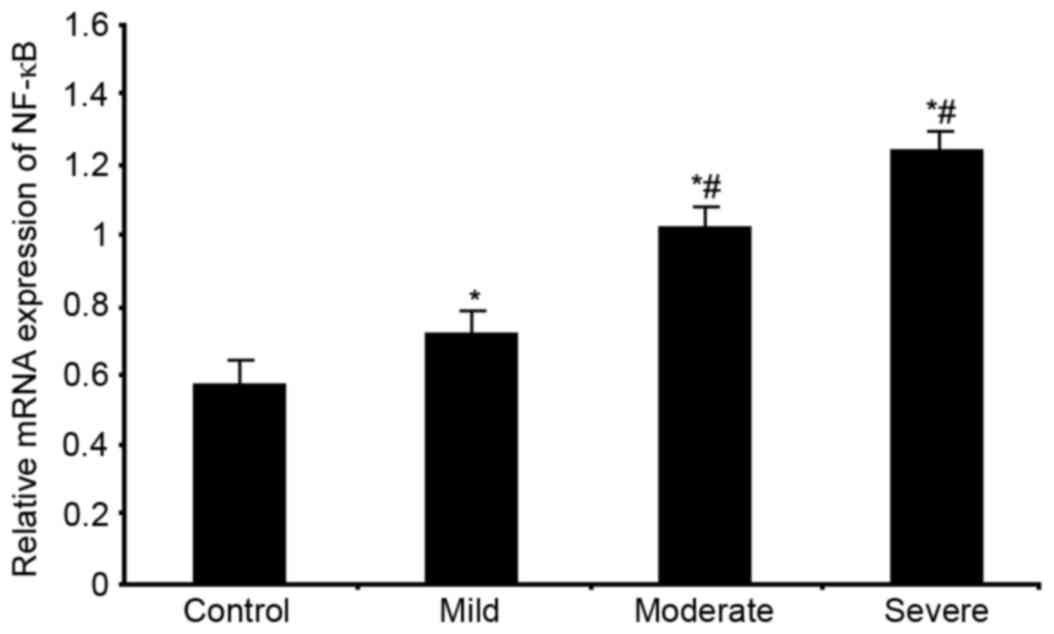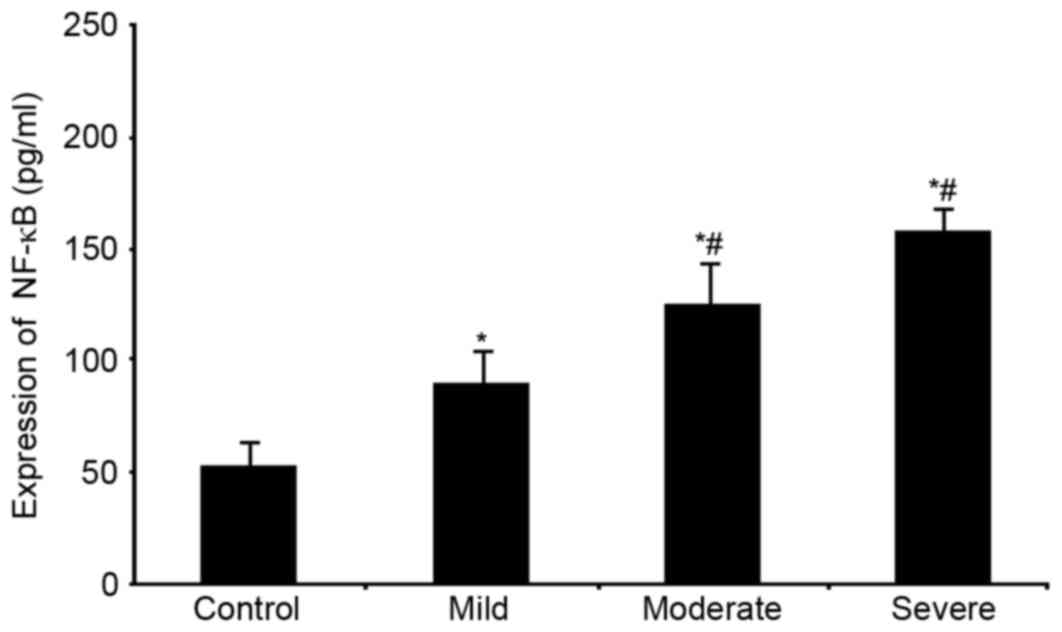Effect of T helper cell 1/T helper cell 2 balance and nuclear factor-κB on white matter injury in premature neonates
- Authors:
- Published online on: January 29, 2018 https://doi.org/10.3892/mmr.2018.8511
- Pages: 5552-5556
Abstract
Introduction
Due to the development of obstetrical techniques and perinatal medicine, and advancement of neonatal intensive care, the survival rate of premature babies has been increased over the years (1,2). Associated complications, however, are also rising, particularly in brain injuries (3). The incidence of neonatal brain injury occurs in >10% of all premature babies (4). Neonatal white matter injury (WMI) is a common type of brain injury in premature babies. Pathological features of WMI include abundant infiltration of microglia, damaged oligodendrocytes, formation of astrocytes, myelin damage and axonal injury. A severe manifestation is the softening of white matter around ventricular zones (5,6). Neonatal WMI is accompanied with neurological injury and neurodevelopment retardation to different extents (7). Severe WMI can cause intelligence and body development disorder, epilepsy, visual-auditory disorder and cerebral palsy, contributing to perinatal mortality and becoming a public health issue worldwide (8,9). Multiple factors can induce premature WMI, including intra-uterus infection, hypoxia, cerebral ischemia and fetal age (9). However, due to insufficient knowledge of WMI pathogenesis, currently no effective treatment exists, leaving only symptomatic treatment with unfavorable efficacy (10). Therefore, studying WMI pathogenesis should draw attention in pediatric and obstetric fields.
T helper cells (Th) can be divided into 2 subgroups, namely Th1 and Th2 cells (11). A recent study demonstrated the cross-regulation and inhibition between Th1 and Th2 cells via modulating cytokine secretion, further maintaining Th1-Th2 balance, and exerting important functions for the normal immune functions of the body (12). Th1 cells mainly secrete interleukin (IL)-2 and tumor necrosis factor-α (TNF-α), while Th2 cells secrete IL-4 and IL-10 (13). Th1/Th2 can maintain a homeostatic condition via self-regulation and cross-regulation targeting secreted cytokines, and it participates in the modulation of cellular and humoral immunity. As a member of transcriptional factor protein family, NF-κB participates in regulating cytokine secretion, and inflammatory or immune responses (14,15). A previous study demonstrated the close association between Th1-biased Th cell transition, plus the secretary level of body cytokines and abnormal expression of nuclear factor (NF)-κB and the occurrence of cerebral injury (16). The current study investigated the expression profile of Th1 and Th2 cytokines in WMI patients, in an attempt to illustrate the role and functions of Th1/Th1 alternation in WMI pathogenesis.
Patients and methods
General information
A total of 60 premature neonatal babies diagnosed with WMI were recruited from the Inner Mongolia People's Hospital (Huhehot, Inner Mongolia) from December 2014 to June 2015. There were 33 males and 27 females (gestation, 28–34 weeks; average gestation, 30±2 weeks; body weight at birth, 1,000–2,500 g; average (mean) body weight, 1,820±350 g). WMI was diagnosed by head ultrasound, which was performed by at least two pediatric consultants.
The exclusive criteriaincluded: Perinatal infection, asphyxia, circulating disorder or ion disorder, those with severe kidney/liver dysfunction, inherited metabolic disorder, major malformation of organs, placental abruption, intra-uterus fetal distress and premature rupture of fetal membranes. The control group included 60 premature neonatal babies without WMI, recruited during the same period. The average gestation period was 31±2 weeks (range, 28–35 weeks), including 22 males and 27 females, with an average body weight at birth of 1,790±420 g (range, 1,000–2,500 g). No statistically significant difference was observed between the two groups regarding body weight. This study was approved by the ethical committee of the Inner Mongolia People's Hospital. Written informed consents were obtained by legal guardians for all participants.
Reagents and equipment
TRIzol reagent, an RNA extraction kit, reverse transcription-quantitative polymerase chain reaction (RT-qPCR) primers, an RT-qPCR kit were all purchased from Invitrogen; Thermo Fisher Scientific, Inc. (Waltham, MA, USA). ELISA kits for IL-2 (cat. no. BMS221-2), TNF-α (cat. no. 88-7346-22), IL-4 (cat. no. BMS225-2), IL-10 (cat. no. BMS215-2) and NF-κB (cat. no. KHO0371) were purchased from eBioscience (Thermo Fisher Scientific, Inc.). A lab system version 1.3.1 micro plate reader was purchased from Bio-Rad Laboratories, Inc. (Hercules, CA, USA). Cell culture incubator was purchased from Suzhou Purification Engineering Installation Co., Ltd. (Suzhou, China). A real time PCR cycler was purchased from Applied Biosystems; Thermo Fisher Scientific, Inc. A UV spectrophotometer was purchased from Mettler-Toledo (Greifensee, Switzerland).
Grouping of WMI patients
Grade of disease was classified into mild [minor reduction of white matter, perturbation of adjacent groves but no ventricular dilation, small and limited high-low signal on magnetic resonance imaging (MRI)], moderate (significantly decreased white matter leaving little white matter between lateral ventricles and gray matter, accompanied with dilation of lateral ventricles) and severe (replacement of white matter by cystic tissues, significantly high signal fusion with lateral ventricle under weighted images and significantly dilated ventricles), based on Flodmar standard and MRI results (17). There were 17, 25 and 18 cases of mild, moderate and severe diseases, respectively.
Sample collection
Blood samples (5 ml) were collected from veins of both disease and control groups 24 h within admitting to the hospital. Blood samples were centrifuged at 3,000 × g for 15 min at room temperature to collect serum, which was frozen at −80°C.
RT-qPCR for the expression profile of Th1/Th1 cytokines in WMI patients
TRIzol reagent was used to extract total RNA from peripheral blood. RNA purity and concentration were determined by UV spectrometry. Reverse transcription was performed using a test kit. cDNA was synthesized with specific primers designed using PrimerPremier 6.0 (www.premierbiosoft.com/primerdesign). RT-qPCR was used to test target gene expression using specific primers (Table I) synthesized by Sangon Biotech Co., Ltd., under the following conditions: 52°C for 1 min, followed by 35 cycles each containing 90°C for 30 sec, 58°C for 50 sec and 72°C for 35 sec. Fluorescent PCR was used to collect all data. Cq values were calculated using the GAPDH gene as the internal reference to plot a standard curve, on which quantitative analysis was performed using the 2−∆∆Cq method (18).
Serum levels of Th1/Th2 cytokines and NF-κB in WMI patients by ELISA
All samples were measured for Th1/Th2 cytokines including IL-2, TNF-α, IL-4, IL-10 and NF-κB, using ELISA kits according to manufacturer's protocol. Linear regression function was plotted based on standard concentration and optical density (OD) values. Sample concentration was deduced on the linear function according to OD values.
Statistical analysis
All data were analysed using SPSS 22.0 software for statistical analysis (IBM Corp., Armonk, NY, USA). At least three independent experiments were performed for each assay. Data are presented as the mean ± standard deviation. Comparison of means among multiple groups was performed by one-way analysis of variance with Newman-Keuls multiple comparison post hoc analysis. Student's t-test was used to compare two groups. Pearson analysis was used for correlation analysis. P<0.05 was considered to indicate a statistically significant difference.
Results
mRNA expression level of the Th1 cytokines IL-2 and TNF-α
RT-qPCR was used to test the mRNA expression levels of the Th1 cytokines IL-2 and TNF-α in all groups. Significantly elevated IL-2 and TNF-α mRNA levels were observed in WMI patients (P<0.05 vs. control group). With aggravated disease condition, the mRNA expression levels of IL-2 and TNF-α were further potentiated (P<0.05 vs. mild patients, Fig. 1).
mRNA expression of the Th2 cytokines IL-4 and IL-10 mRNA expression in WMI patients
RT-qPCR was used to test the mRNA expression levels of the Th2 cytokines IL-4 and IL-10 in all groups. Significantly decreased IL-4 and IL-10 mRNA expression levels were observed in WMI patients (P<0.05 vs. control group). With aggravated disease condition, the mRNA expression levels of IL-4 and IL-10 were further decreased (P<0.05 vs. mild patients, Fig. 2).
Serum levels of Th1 cytokines IL-2 and TNF-α in WMI neonates
ELISA was used to measure serum levels of the Th1 cytokines IL-2 and TNF-α in all WMI neonates. The results were similar results to the mRNA ones, as significantly elevated serum IL-2 and TNF-α levels were observed in WMI patients (P<0.05 vs. control group). With aggravated disease condition, serum levels of IL-2 and TNF-α were further potentiated (P<0.05 vs. mild patients, Fig. 3).
Serum levels of Th2 cytokines IL-4 and IL-10 in WMI neonates
ELISA was used to measure serum levels of the Th2 cytokines IL-4 and IL-10 in all WMI neonates. The results were similar results to the mRNA ones, as significantly lowered serum IL-4 and IL-10 levels were observed in WMI patients (P<0.05 vs. control group). With aggravated disease condition, serum level of IL-4 and IL-10 was further suppressed (P<0.05 vs. mild patients, Fig. 4).
mRNA and protein expression of NF-κB in serum of WMI premature neonates
RT-qPCR and ELISA were used to analyse the mRNA and protein expression profiles of NF-κB in premature neonates with WMI, respectively. Significantly elevated NF-κB mRNA expression levels were observed in patients (P<0.05 vs. control group, Fig. 5). With aggravated disease condition, NF-κB mRNA expression levels were further elevated (P<0.05 vs. mild group, Fig. 5). Similar to those of mRNA, serum NF-κB levels were significantly elevated in the disease group, and in the severe sub-group (P<0.05, Fig. 6).
Correlation between serum Th1 and Th2 cytokines and NF-κB in WMI neonates
The correlation between Th1 and Th2 cytokines in serum of WMI patients was further analysed. The results demonstrated that IL-2, TNF-α and NF-κB were negatively correlated with IL-4 and IL-10 (P<0.05, Table II).
Correlation between serum Th1/Th2 cytokines and NF-κB and disease severity
The correlation between Th1/Th2 cytokines in the serum of WMI patients and their disease severity was further analysed. The results demonstrated that IL-2, TNF-α and NF-κB expression were positively correlated with disease severity, whilst IL-4 and IL-10 expression were negatively correlated with disease severity (P<0.05, Table III).
Discussion
A complicated pathogenesis mechanism exists for WMI in neonates. Intra-uterine factors and ischemia-reperfusion are two major determinants of WMI (19). In an intra-uterus infection model by LPS injection, and another neonatal mouse model of hypoxia-ischemia, ventricular dilation, significant diffused WMI and softening lesion in cerebral white matter can be observed (20). In the intra-uterus infection model, inflammatory cytokines including TNF-α, IL-6 and interferon-γ are elevated, in addition to an altered cytokine network in the uterus of pregnant mice (21). This indicates a possible role of Th1/Th2 in WMI pathogenesis. The change of Th1/Th2 balance and NF-κB are closely correlated with occurrence of cerebral injury. The role of Th1/Th2 imbalance and NF-κB, however, remains to be illustrated. The same stands for the underlying mechanisms.
Among various factors secreted by Th1 cells, TNF-α and IL-2 are two representative cytokines. Hypoxia and ischemia cause elevated number of Th1 cells, leading to enhanced secretion of TNF-α and IL-2, causing chronic inflammation. Therefore, elevated secretion of Th1-associated cytokines is an important factor during inflammation. When the body is under inflammatory change, abundant activation of inflammatory and immune-associated genes occur, inducing elevated expression of cytokines including TNF-α and IL-2, thus modulating a complex cytokine network inside the body (22). NF-κB is a transcription factor widely distributed in eukaryotic cells, governing multiple pathological processes including inflammation, immune response, cell apoptosis and proliferation (23). The present study demonstrated significantly higher mRNA and protein expression levels of TNF-α and IL-2 in WMI patients compared with the control group. With further aggravation of disease severity, TNF-α and IL-2 levels were further elevated. IL-4 and IL-10 were further suppressed with advanced disease condition. A correlation analysis between Th1/Th2 cytokines in WMI patients revealed a negative correlation between TNF-α and IL-2, and Il-4 and IL-10. Disease severity was positively correlated with TNF-α and IL-2 expression, and was negatively correlated with IL-4 and IL-10. These results demonstrated that the facilitation of secretion of the inflammatory factors TNF-α and IL-2 could activate the inflammatory response, leading to leukocyte adhesion, maturation and migration of immune cells, which might lead to further progression of inflammation, eventually leading to death of oligodendrocytes, impairing myelination in the central nervous system, and further severity of WMI (24). Cytokines released by Th1 and Th2 cells can antagonize each other and inhibit Th response and release of associated factors, thus enhancing the humoral immune response and exerting protective roles (25). NF-κB activation leads to elevated expression of inflammatory factors, especially the Th1-secreted cytokines TNF-α and IL-2, suggesting a positive feedback loop mechanism of TNF-α for secretion of inflammatory factors (25). During WMI pathogenesis, NF-κB upregulation increases secretion of TNF-α and IL-2, both of which inhibit secretion of IL-4 and IL-10, leading to Th1/Th2 imbalance, and making a pathological progression of WMI. Therefore, the present study provided evidence for studying WMI pathogenesis.
In conclusion, during WMI pathogenesis, NF-κB upregulation increases the secretion of Th1 cytokines and decreases the secretion of Th2 cytokines, causing Th1/Th2 imbalance, which may be a potential risk marker for the early detection or treatment of WMI.
References
|
Pagnozzi AM, Dowson N, Doecke J, Fiori S, Bradley AP, Boyd RN and Rose S: Automated, quantitative measures of grey and white matter lesion burden correlates with motor and cognitive function in children with unilateral cerebral palsy. Neuroimage Clin. 11:751–759. 2016. View Article : Google Scholar : PubMed/NCBI | |
|
Zhang Z, Bassam B, Thomas AG, Williams M, Liu J, Nance E, Rojas C, Slusher BS and Kannan S: Maternal inflammation leads to impaired glutamate homeostasis and up-regulation of glutamate carboxypeptidase II in activated microglia in the fetal/newborn rabbit brain. Neurobiol Dis. 94:116–128. 2016. View Article : Google Scholar : PubMed/NCBI | |
|
Li J, Yawno T, Sutherland A, Loose J, Nitsos I, Bischof R, Castillo-Melendez M, McDonald CA, Wong FY, Jenkin G and Miller SL: Preterm white matter brain injury is prevented by early administration of umbilical cord blood cells. Exp Neurol. 283:179–187. 2016. View Article : Google Scholar : PubMed/NCBI | |
|
Sandhu MS, Ross HH, Lee KZ, Ormerod BK, Reier PJ and Fuller DD: Intraspinal transplantation of subventricular zone-derived neural progenitor cells improves phrenic motor output after high cervical spinal cord injury. Exp Neurol. 287:205–215. 2017. View Article : Google Scholar : PubMed/NCBI | |
|
Stetler RA, Gao Y, Leak RK, Weng Z, Shi Y, Zhang L, Pu H, Zhang F, Hu X, Hassan S, et al: APE1/Ref-1 facilitates recovery of gray and white matter and neurological function after mild stroke injury. Proc Natl Acad Sci USA. 113:pp. E3558–E3567. 2016; View Article : Google Scholar : PubMed/NCBI | |
|
Ceschin R, Lee VK, Schmithorst V and Panigrahy A: Regional vulnerability of longitudinal cortical association connectivity: Associated with structural network topology alterations in preterm children with cerebral palsy. Neuroimage Clin. 9:322–337. 2015. View Article : Google Scholar : PubMed/NCBI | |
|
Serdar M, Herz J, Kempe K, Lumpe K, Reinboth BS, Sizonenko SV, Hou X, Herrmann R, Hadamitzky M, Heumann R, et al: Fingolimod protects against neonatal white matter damage and long-term cognitive deficits caused by hyperoxia. Brain Behav Immun. 52:106–119. 2016. View Article : Google Scholar : PubMed/NCBI | |
|
Cheng I, Miller SP, Duerden EG, Sun K, Chau V, Adams E, Poskitt KJ, Branson HM and Basu A: Stochastic process for white matter injury detection in preterm neonates. Neuroimage Clin. 7:622–630. 2015. View Article : Google Scholar : PubMed/NCBI | |
|
Ranchhod SM, Gunn KC, Fowke TM, Davidson JO, Lear CA, Bai J, Bennet L, Mallard C, Gunn AJ and Dean JM: Potential neuroprotective strategies for perinatal infection and inflammation. Int J Dev Neurosci. 45:44–54. 2015. View Article : Google Scholar : PubMed/NCBI | |
|
Bentzley JP, Coker-Bolt P, Moreau NG, Hope K, Ramakrishnan V, Brown T, Mulvihill D and Jenkins D: Kinematic measurement of 12-week head control correlates with 12-month neurodevelopment in preterm infants. Early Hum Dev. 91:159–164. 2015. View Article : Google Scholar : PubMed/NCBI | |
|
Tian T, Yu S, Liu L, Xue F, Yuan C, Wang M, Ji C and Ma D: The profile of T helper subsets in bone marrow microenvironment is distinct for different stages of acute myeloid leukemia patients and chemotherapy partly ameliorates these variations. PLoS One. 10:e01317612015. View Article : Google Scholar : PubMed/NCBI | |
|
Vargas-Rojas MI, Solleiro-Villavicencio H and Soto-Vega E: Th1, Th2, Th17 and Treg levels in umbilical cord blood in preeclampsia. J Matern Fetal Neonatal Med. 29:1642–1645. 2016. View Article : Google Scholar : PubMed/NCBI | |
|
Song KH, Kim MH, Kang SM, Jung SY, Ahn J, Woo HJ, Nam SY, Hwang SG, Ryu SY and Song JY: Analysis of immune cell populations and cytokine profiles in murine splenocytes exposed to whole-body low-dose irradiation. Int J Radiat Biol. 91:795–803. 2015. View Article : Google Scholar : PubMed/NCBI | |
|
Kornete M, Mason ES, Girouard J, Lafferty EI, Qureshi S and Piccirillo CA: Th1-Like ICOS+ Foxp3+ treg cells preferentially express CXCR3 and home to β-Islets during pre-diabetes in BDC2.5 NOD mice. PLoS One. 10:e01263112015. View Article : Google Scholar : PubMed/NCBI | |
|
Wang J, Cao H, Wang H, Yin G, Du J, Xia F, Lu J and Xiang M: Multiple mechanisms involved in diabetes protection by lipopolysaccharide in non-obese diabetic mice. Toxicol Appl Pharmacol. 285:149–158. 2015. View Article : Google Scholar : PubMed/NCBI | |
|
Kong F, Zhang W, Feng B, Zhang H, Rao H, Wang J, Cong X and Wei L: Abnormal CD4 + T helper (Th)1 cells and activated memory B cells are associated with type III asymptomatic mixed cryoglobulinemia in HCV infection. Virol J. 12:1002015. View Article : Google Scholar : PubMed/NCBI | |
|
Whitaker AH, Feldman JF, Lorenz JM, McNicholas F, Fisher PW, Shen S, Pinto-Martin J, Shaffer D and Paneth N: Neonatal head ultrasound abnormalities in preterm infants and adolescent psychiatric disorders. Arch Gen Psychiatry. 68:742–752. 2011. View Article : Google Scholar : PubMed/NCBI | |
|
Livak KJ and Schmittgen TD: Analysis of relative gene expression data using real-time quantitative PCR and the 2(-Delta Delta C(T)) method. Methods. 25:402–408. 2001. View Article : Google Scholar : PubMed/NCBI | |
|
Constable RT, Ment LR, Vohr BR, Kesler SR, Fulbright RK, Lacadie C, Delancy S, Katz KH, Schneider KC, Schafer RJ, et al: Prematurely born children demonstrate white matter microstructural differences at 12 years of age, relative to term control subjects: An investigation of group and gender effects. Pediatrics. 121:306–316. 2008. View Article : Google Scholar : PubMed/NCBI | |
|
Woodward LJ, Edgin JO, Thompson D and Inder TE: Object working memory deficits predicted by early brain injury and development in the preterm infant. Brain. 128:2578–2587. 2005. View Article : Google Scholar : PubMed/NCBI | |
|
Anand G, Vasanthakumar R, Mohan V, Babu S and Aravindhan V: Increased IL-12 and decreased IL-33 serum levels are associated with increased Th1 and suppressed Th2 cytokine profile in patients with diabetic nephropathy (CURES-134). Int J Clin Exp Pathol. 7:8008–8015. 2014.PubMed/NCBI | |
|
Zabetian-Targhi F, Mirzaei K, Keshavarz SA and Hossein-Nezhad A: Modulatory role of omentin-1 in inflammation: Cytokines and dietary intake. J Am Coll Nutr. 35:670–678. 2016. View Article : Google Scholar : PubMed/NCBI | |
|
Lee CH, Park JH, Ahn JH and Won MH: Effects of melatonin on cognitive impairment and hippocampal neuronal damage in a rat model of chronic cerebral hypoperfusion. Exp Ther Med. 11:2240–2246. 2016. View Article : Google Scholar : PubMed/NCBI | |
|
Coomes SM, Pelly VS, Kannan Y, Okoye IS, Czieso S, Entwistle LJ, Perez-Lloret J, Nikolov N, Potocnik AJ, Biró J, et al: IFNγ and IL-12 restrict Th2 responses during helminth/plasmodium co-infection and promote IFNγ from Th2 cells. PLoS Pathog. 11:e10049942015. View Article : Google Scholar : PubMed/NCBI | |
|
Wang TY, Lee SY, Chen SL, Chang YH, Wang LJ, Chen PS, Chen SH, Chu CH, Huang SY, Tzeng NS, et al: Comparing clinical responses and the biomarkers of BDNF and cytokines between subthreshold bipolar disorder and bipolar II disorder. Sci Rep. 6:274312016. View Article : Google Scholar : PubMed/NCBI |



